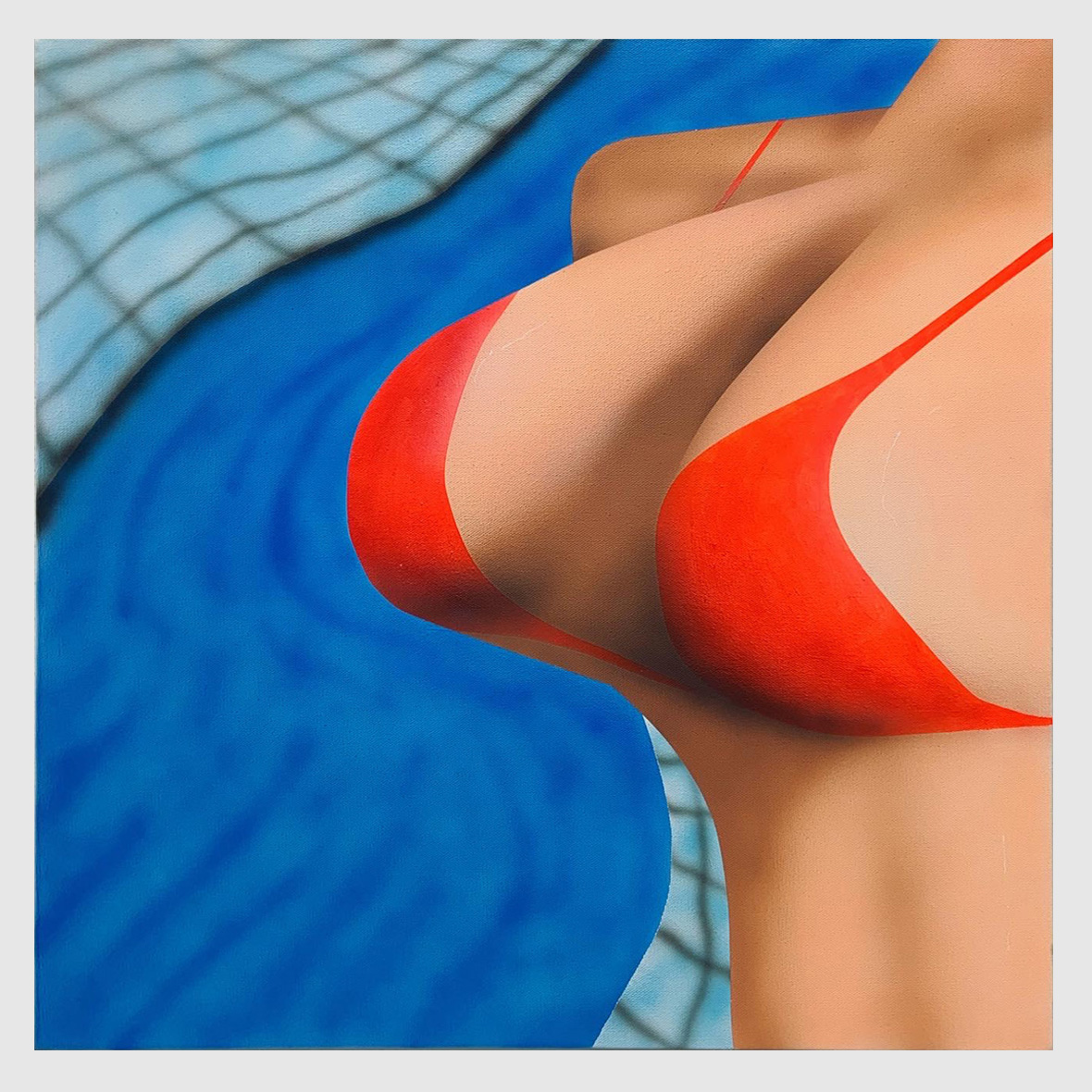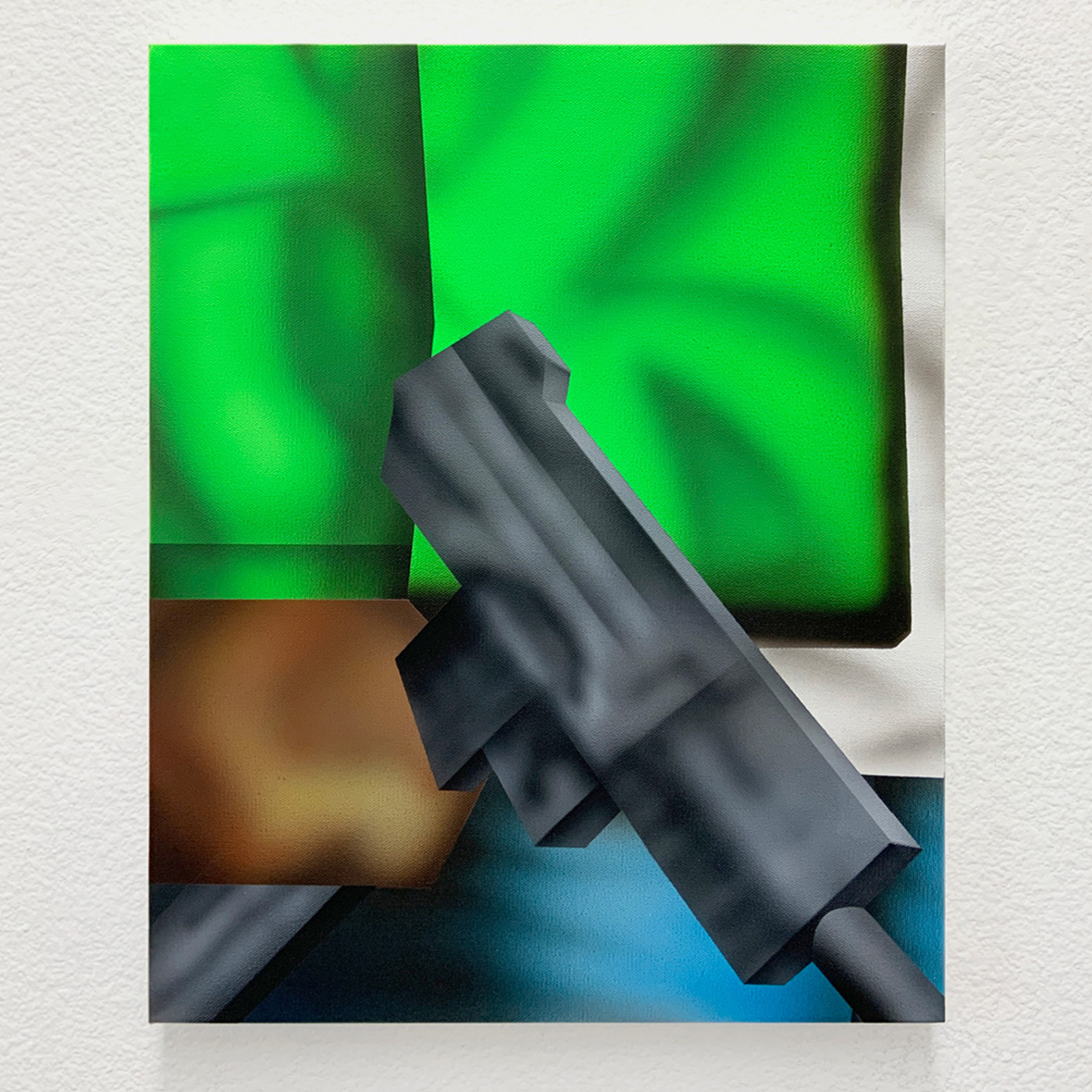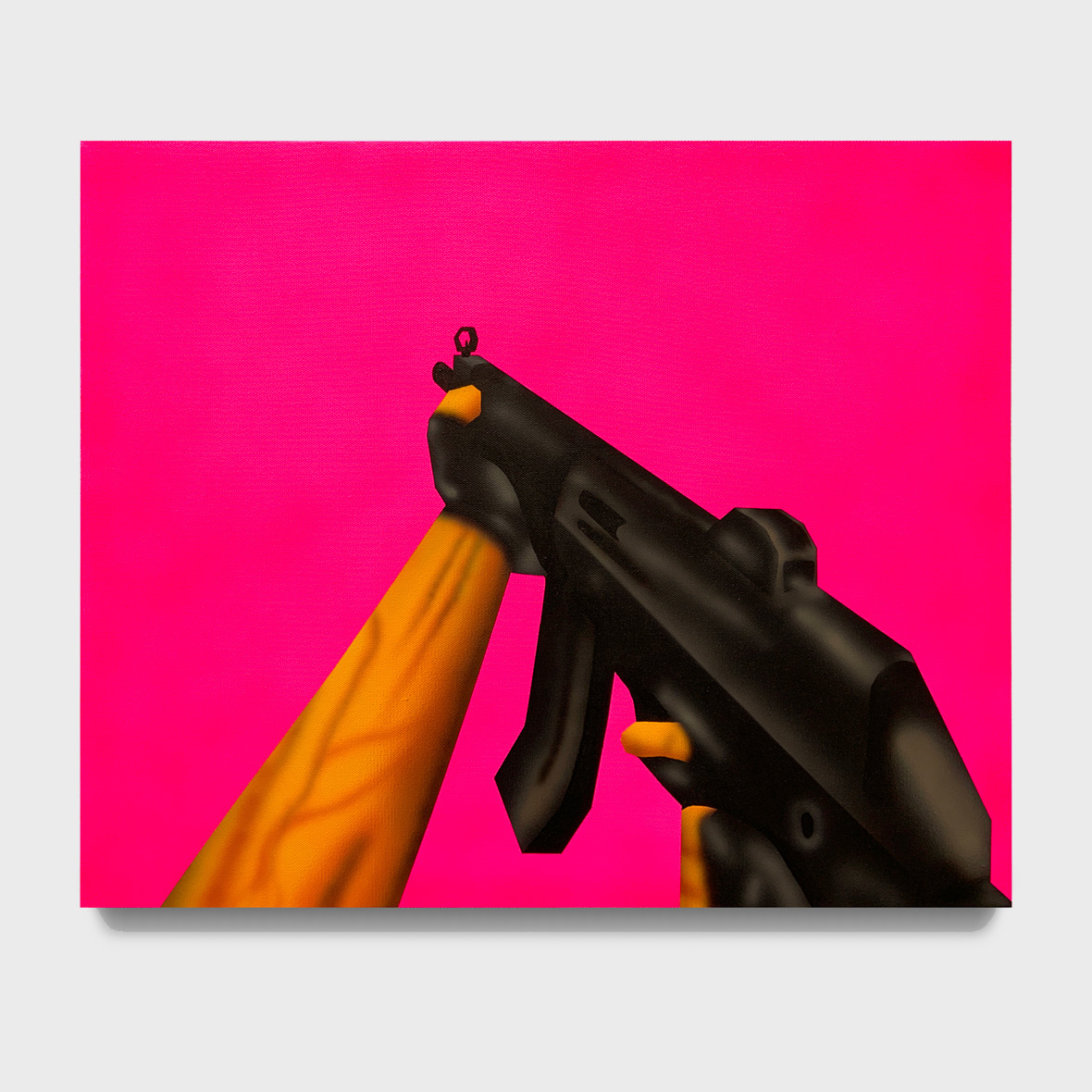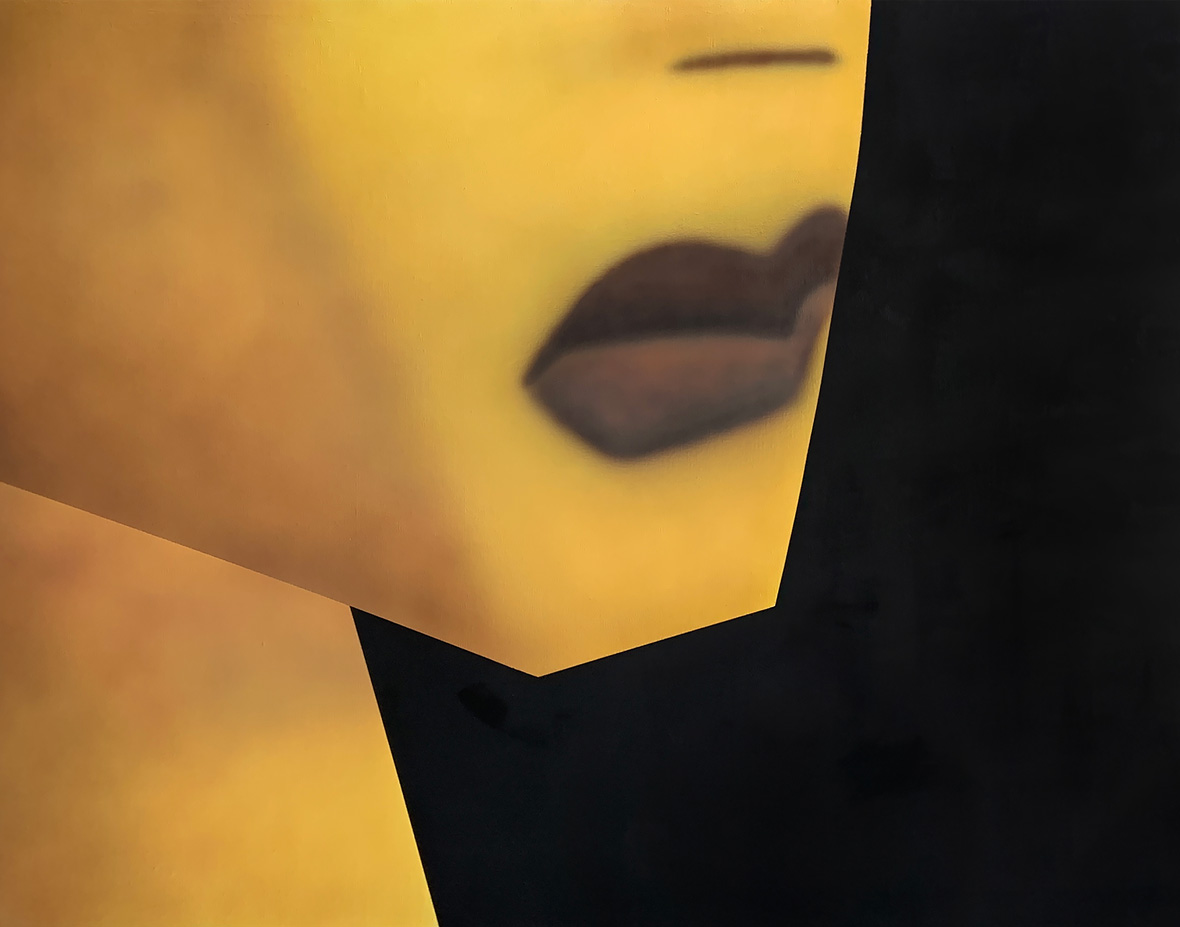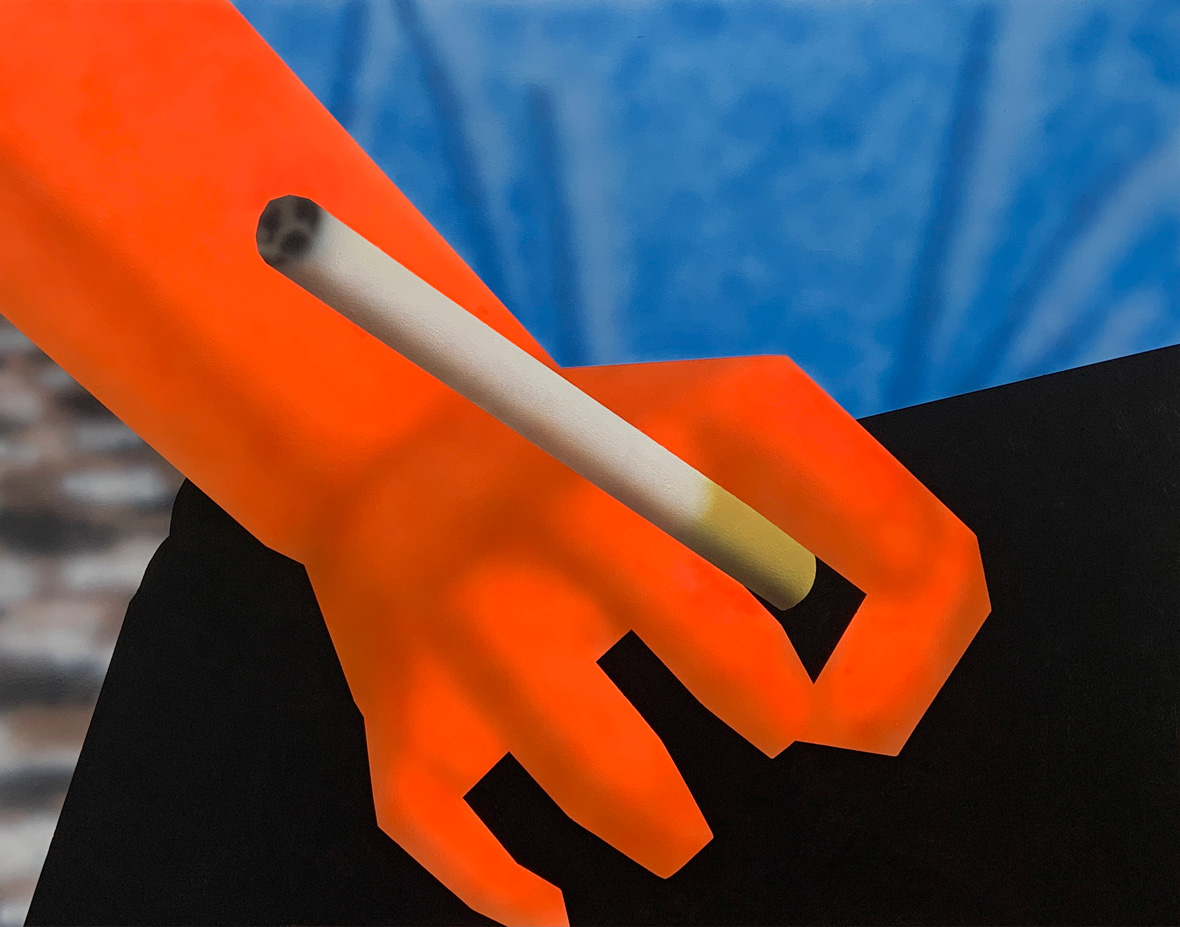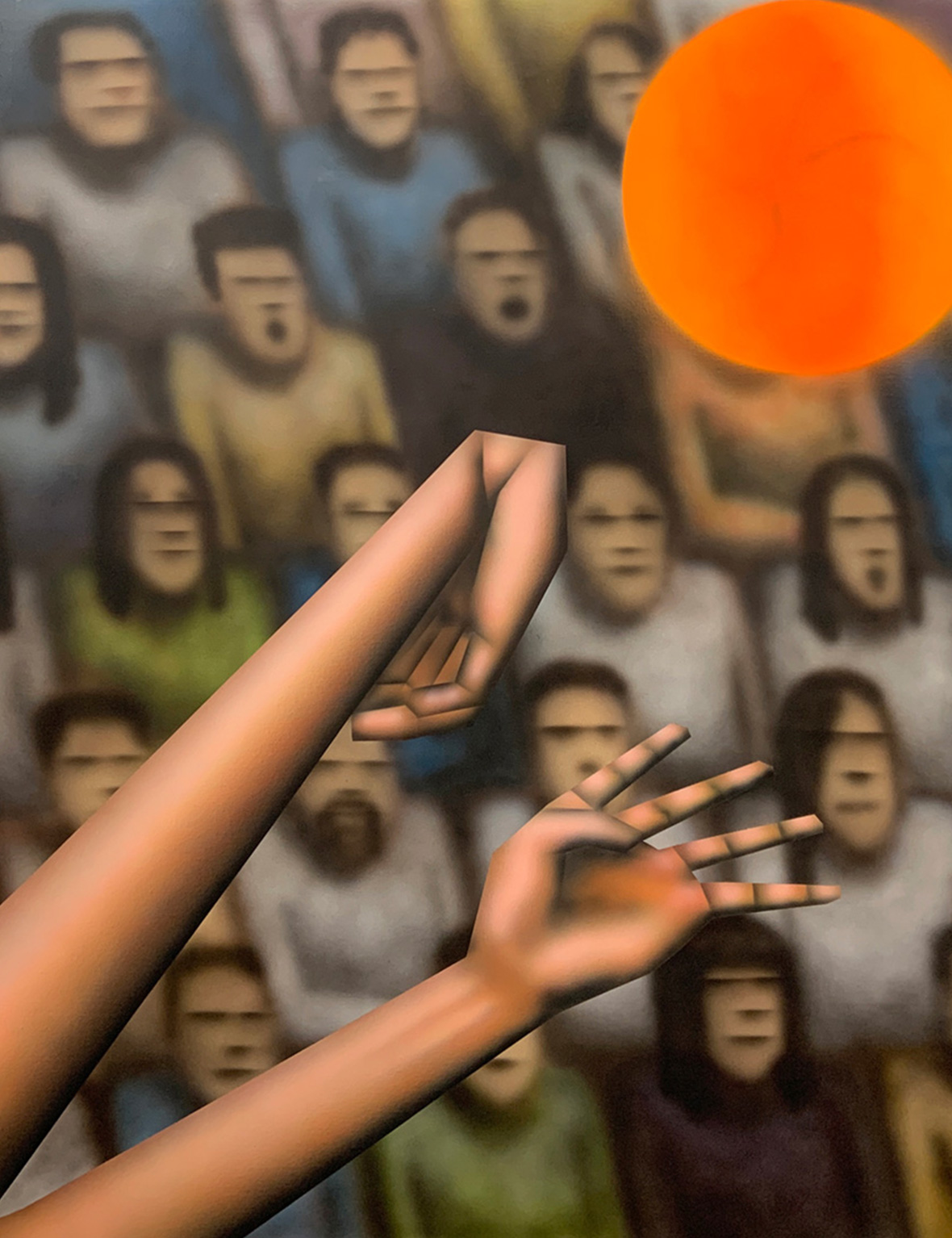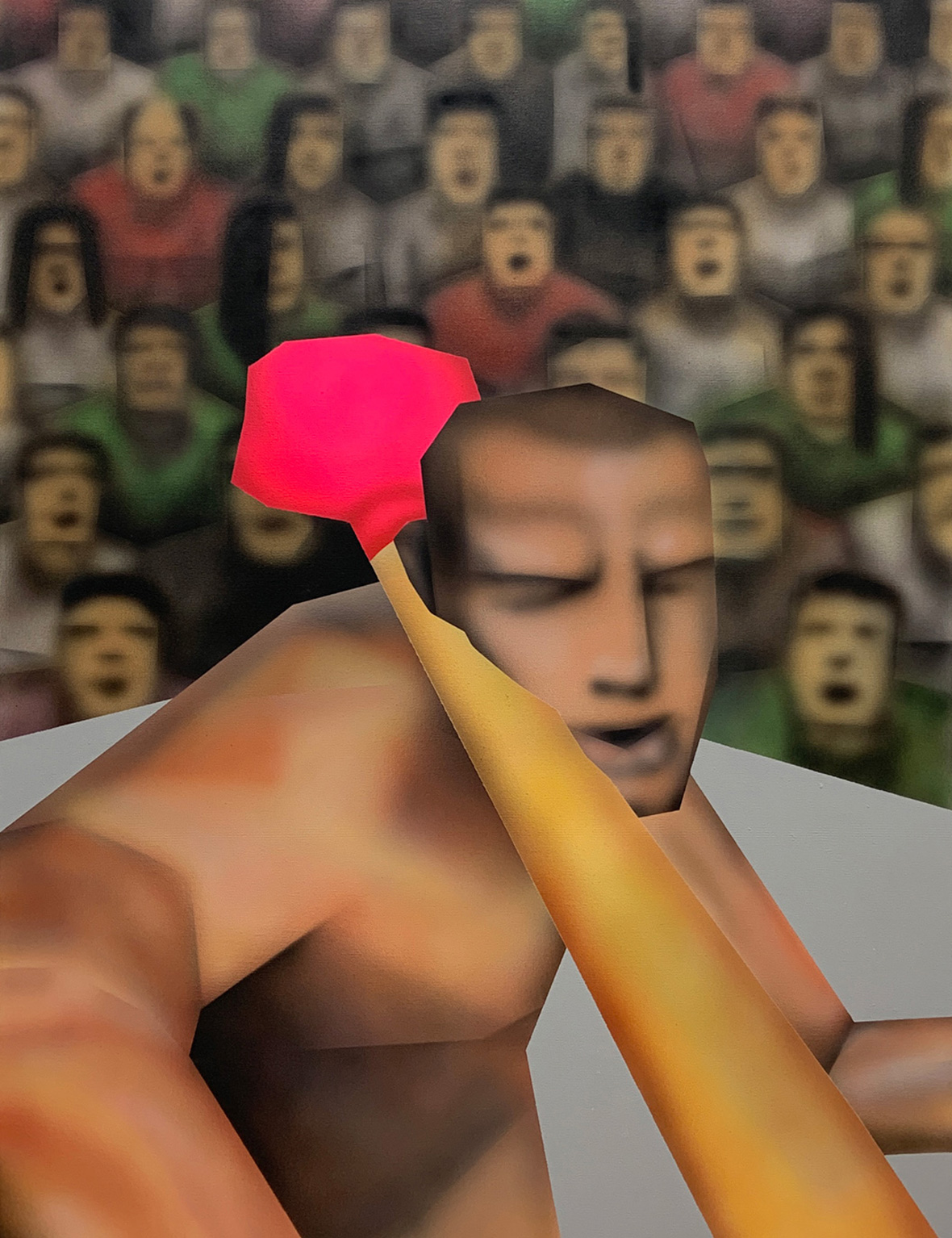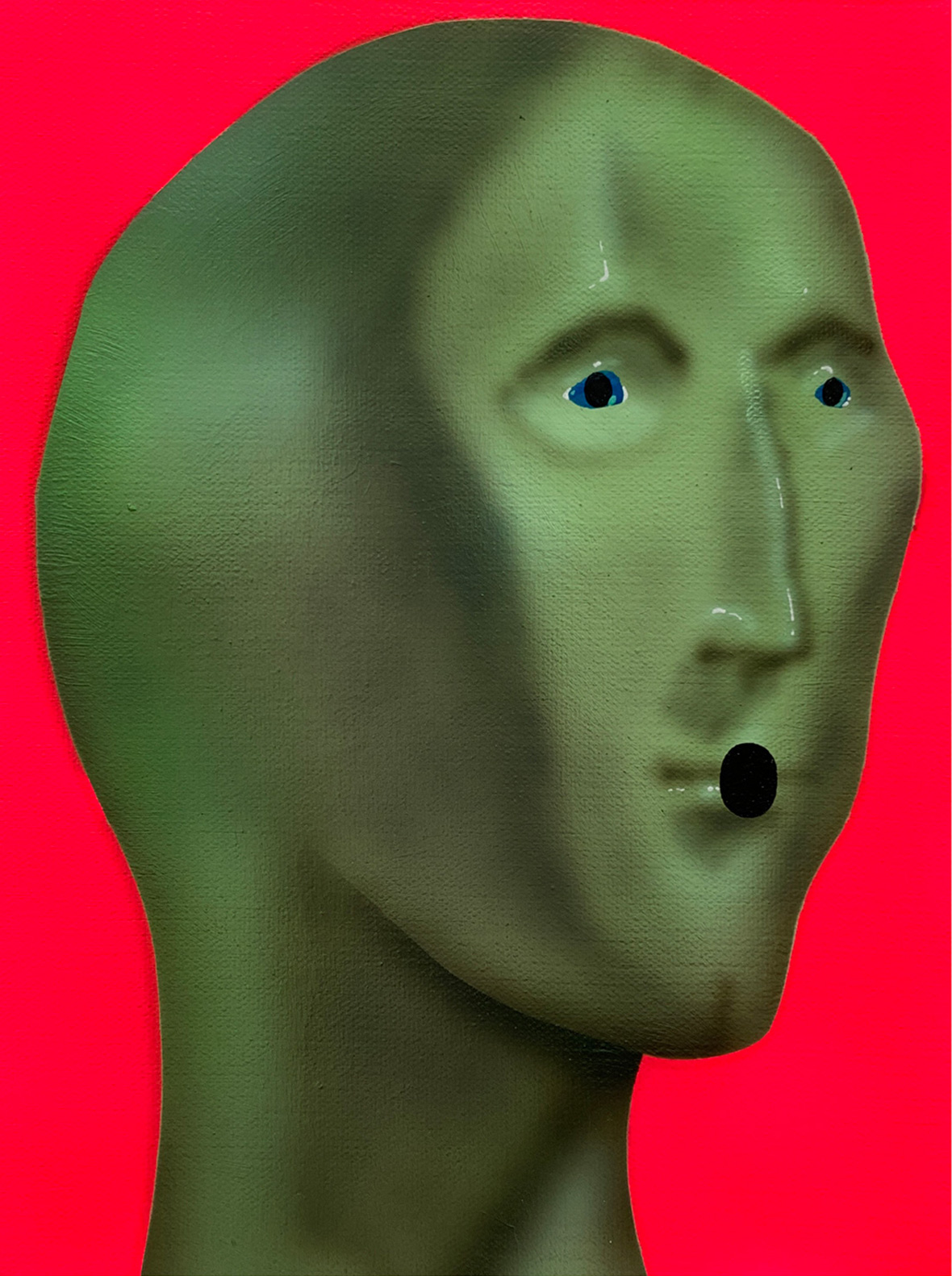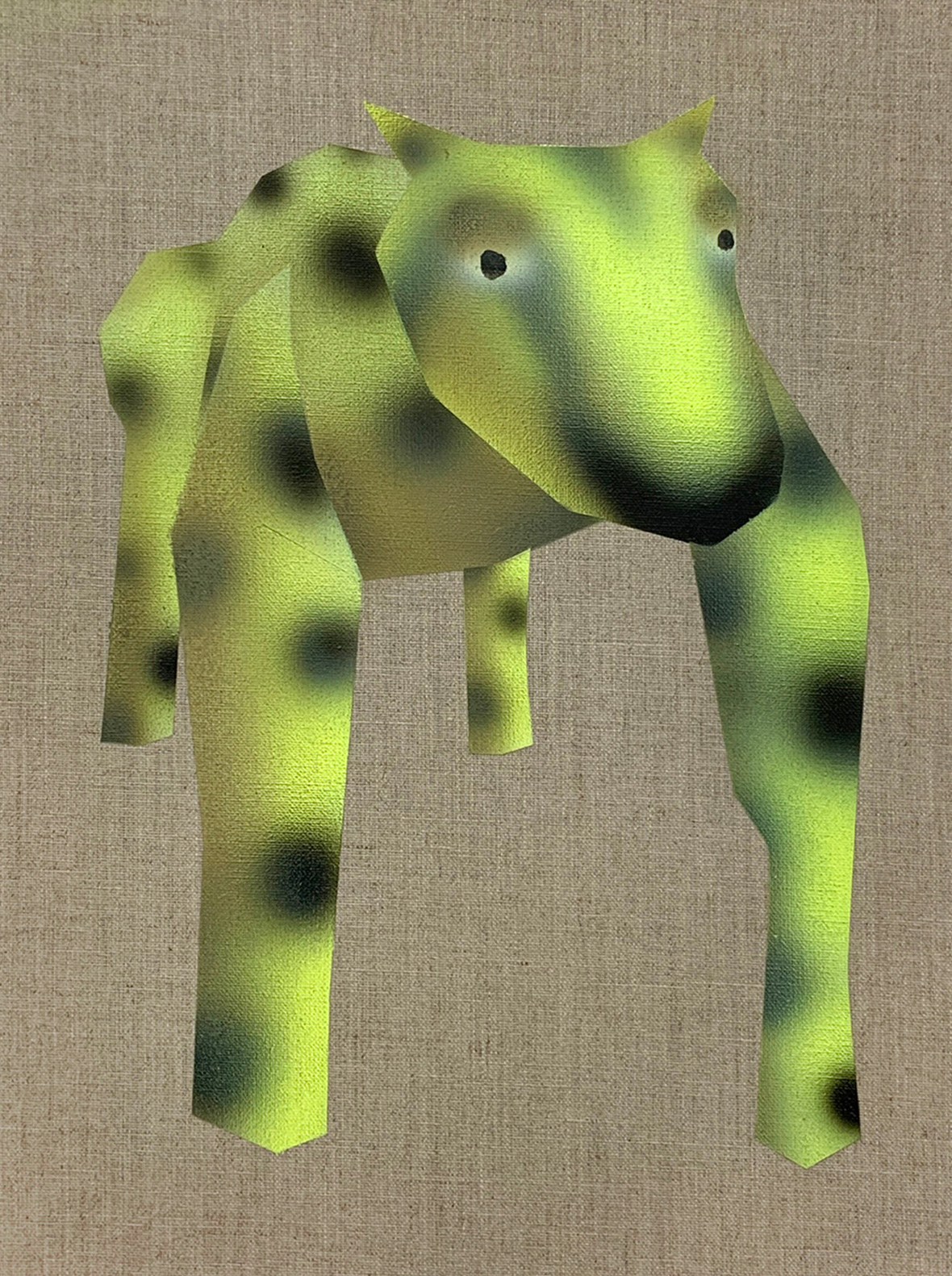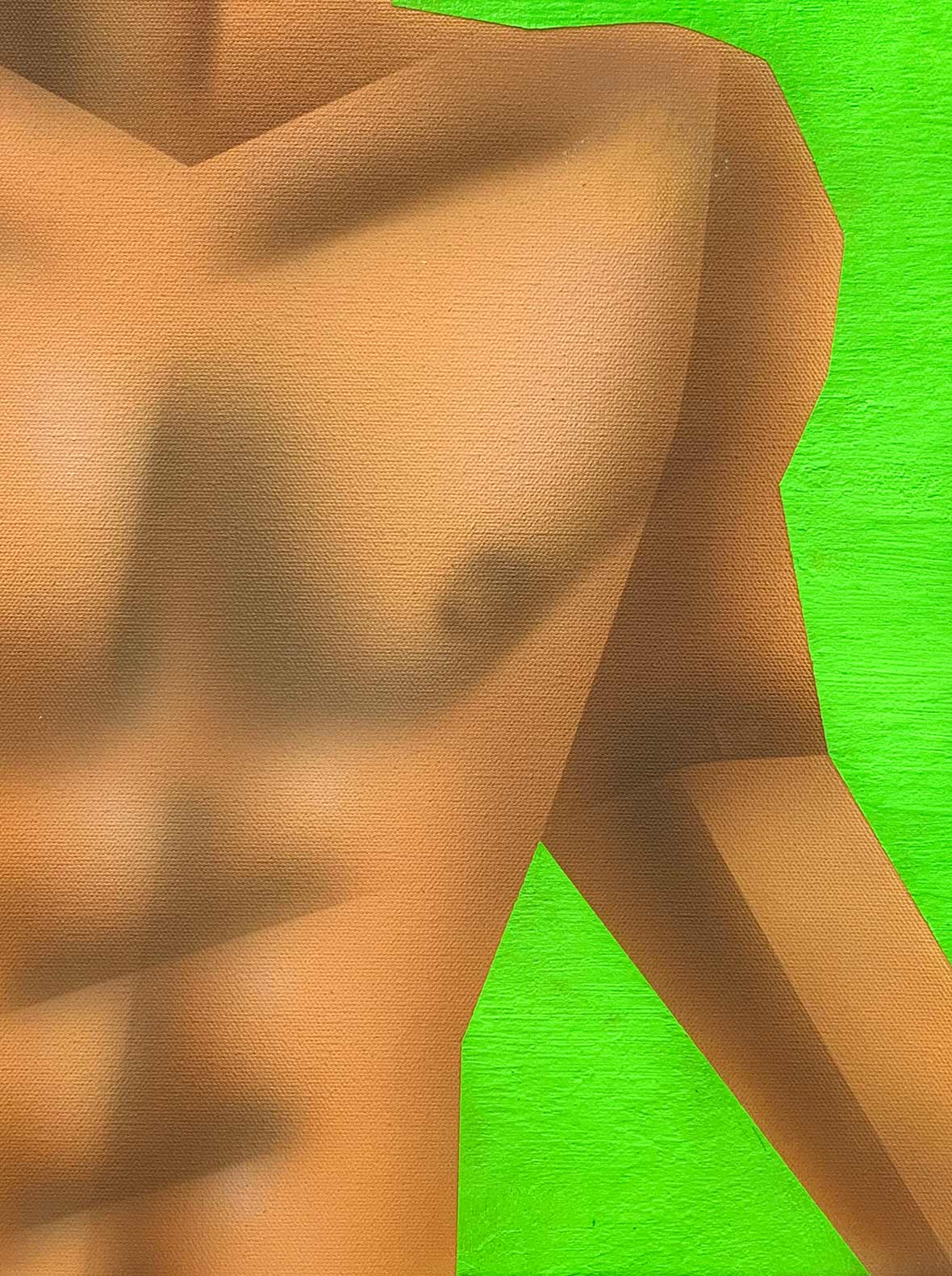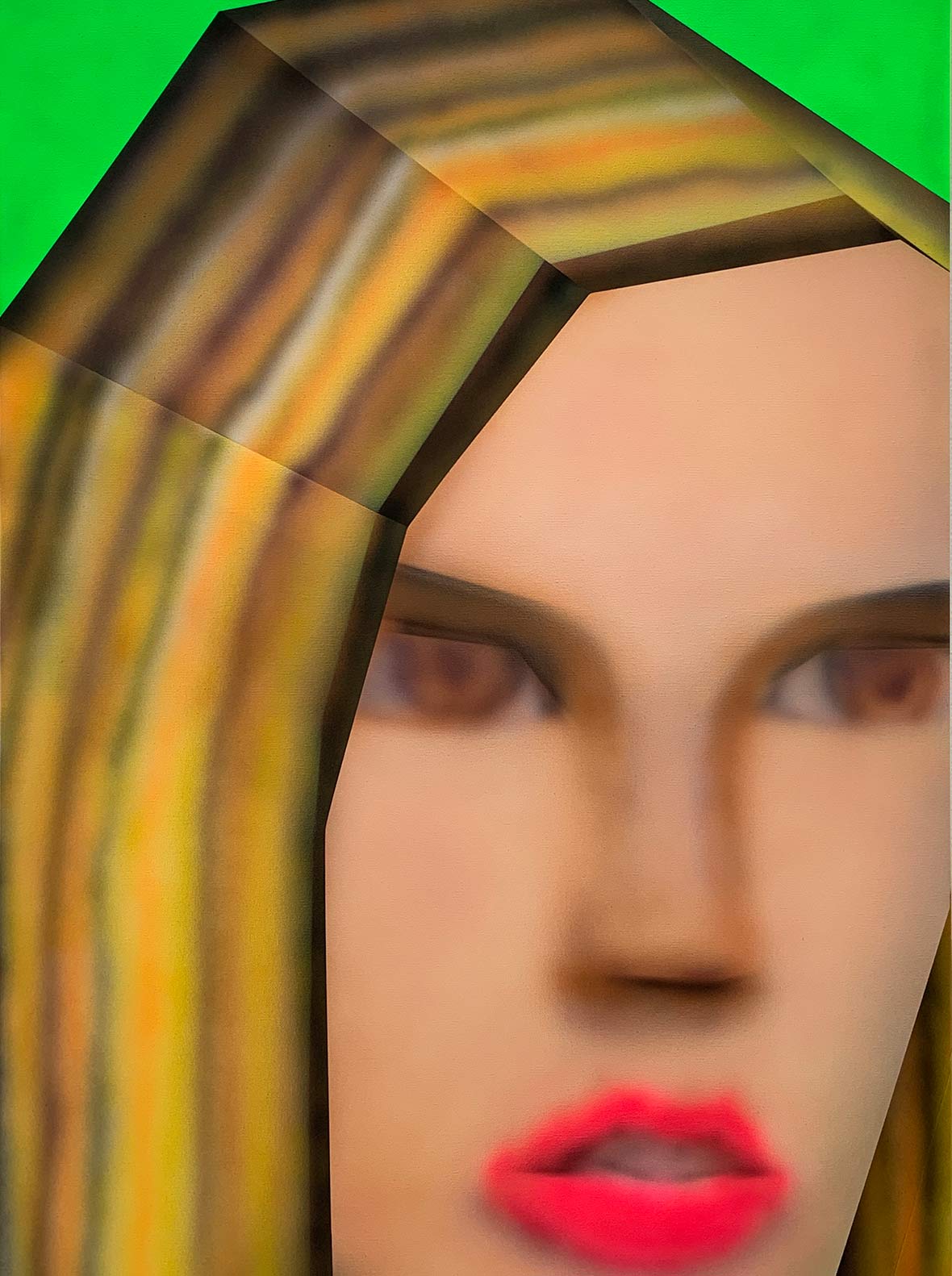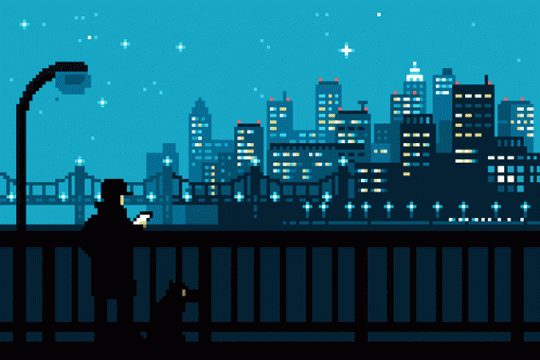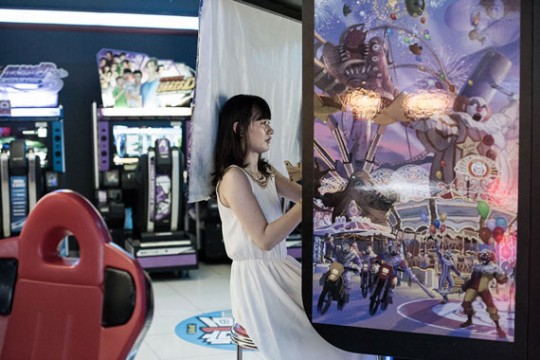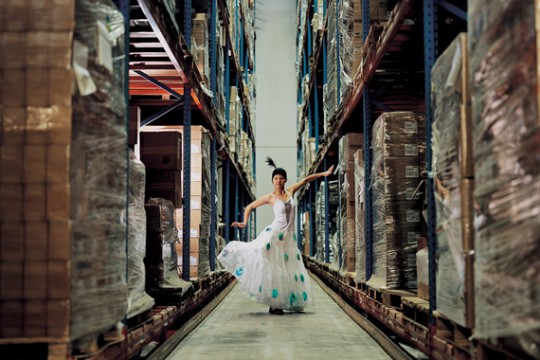
Low-poly graphics and textures have recently become a trend in the indie video-game scene. Moved by nostalgia and a desire to harness the players’ imaginations, developers have reclaimed the PS1 and N64 aesthetics of the 1990s in a handful of last generation games. But it’s unexpected to see such a style in the fine-arts world.
Houston-based Chinese artist Gao Hang proudly exhibits his low-poly art on the walls of galleries. In his latest series of paintings, sarcastically titled 21st Century Realism, he reflects on our infotech era and how the fast-paced spread of information affects our social and consumer lives. Contrary to the title, however, his paintings are far from realistic. They mix low-poly style with the mischievous spirit of the internet memes to form a satirical commentary on this generation’s online behavior.
近年来,独立电子游戏界掀起一股 Low Poly 风潮,这种设计通常以低保真、低多边形的特点著称。游戏开发者们参考上世纪 90 年代 Playstation 初代和任天堂 N64 经典游戏美学,打造数款游戏。在满足不少玩家的怀旧情绪同时,缺少具像化的画面也能激发出无限想象力。出人意料的是,这股风潮现在已蔓延到了艺术创作领域。
现居美国休斯顿的中国艺术家高航近期创作了一系列低多边形风格的作品,目前已在当地大大小小的画廊上展出。这一系列画作起名为《21st Century Realism》(21世纪现实主义),略带几分调侃的意味。他的创作以当前信息技术时代、以及信息快速传播对社会和消费生活的影响为话题展开。与系列名字的含义截然相反,他的画作与现实和写实毫不沾边,取而代之的,是低多边形风格设计与“电子图像代沟”和“迷因”的恶搞精神,借此讽刺当代网民的种种线上举动。
“My creative process has to do with my habits and obsessions,” he says. “I mostly listen to standup comedy while working. I like it when comedy challenges general beliefs and political correctness. In a way, my paintings are like standup comedy, with brutal honesty and humor—powerful qualities in any conversation.”
Gao scours the internet in search of images to reference for his paintings. But he never reproduces them in full. Instead, he prefers reimagining how the image may look from different angles or with a different composition. Finally, he reduces them into primitive polygon shapes and colors, airbrushing the imagery with acrylic paint on canvas.
He’s drawn to visuals that feel awkward and unpolished, as is the case with retro video games. Aiming to recreate the same feeling in his works, he often depicts close-ups of characters holding guns and first-person perspectives. Gao cites classics like GoldenEye 007, for Nintendo 64, and the PC game Counter-Strike 1.4 as inspiration. “I think my fascination [with video games] started in my formative years, and it psychologically shocked me,” he says. “I know we have VR games nowadays, but these old games provided legit immersion back then. Even if we think their graphics were poor, we were more than pleased with them.”
高航说:“我的创作和我沉迷的喜好多少脱不了干系。平时创作的时候,喜欢播放一些单口喜剧。其中各种挑战传统观念和政治正确的桥段尤其吸引我。而在某种角度来讲,我的作品就像是单口喜剧, 赤裸的诚实和调侃的态度,在任何类别的语言交流中都很有质感和质量。”
高航经常在网上搜罗各种图片,并以此作为创作灵感,但从不会一五一十地照搬。他习惯从不同角度或用不同的构图方式出发,用自己的视觉语言对原本画面进行重新演绎。然后将图像简化成粗糙的多边形色块,再在画布上用丙烯酸颜料进行喷绘。
笨拙、粗糙的视觉效果令高航着迷,总会令人联想起过去的电子游戏。为了让作品呈现游戏界面的效果,他常常对人物进行特写,或是以第一人称视角来进行构图。高航的灵感包括经典的 N64 游戏《黄金眼007》和 PC 端《反恐精英》。他说:“小时候就特别沉迷。那时候电子游戏带给我很大的冲击。我知道现在连 VR 游戏都有了,但在当时,这些游戏中的电子图像画质对我们来说已经达到完美逼真,但有趣的是,这些在十几年后的今天看来,是那么的笨拙、粗糙、滑稽。”
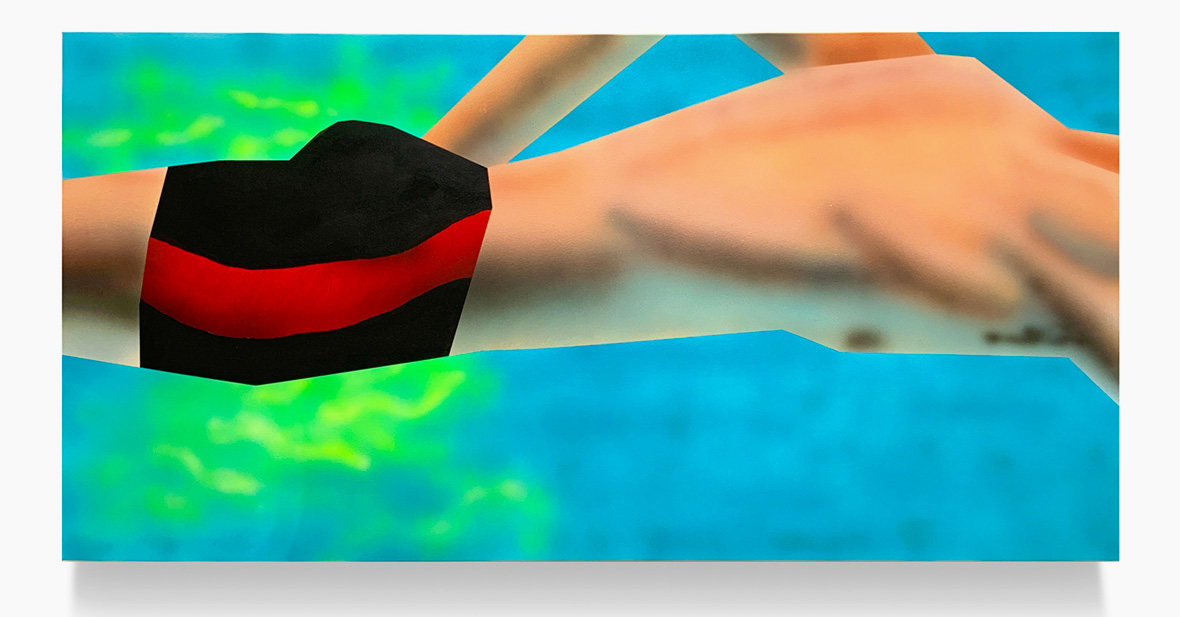
Though he includes recognizable elements in his paintings, Gao describes his works as being his take on color field paintings. He’s interested in the significance of colors, particularly fluorescents because they represent scientific innovation, one that’s enabled an entirely new visual experience in the last century. In his works, fluorescent colors are a metaphor for people’s social media behavior. “If you don’t broadcast yourself, you disappear,” he explains. “We have to be fluorescent, visually aggressive—or just aggressive.” Gao admits he doesn’t like social media, but he’s on it nevertheless. “Otherwise, I don’t exist,” he says.
在高航绘画中,事物和人物的轮廓清晰分明。但他认为自己的创作更偏向于色域绘画(color field painting)。他热衷于在作品中探讨颜色的奥义。荧光色则是作品中最为常见的色系,这类颜色往往在感官上带给人有一种科技、前卫的体验。在他看来,上个世纪人类在视觉方面的发展与科技密不可分。而放在作品中,荧光色则被用作是对社交媒体行为的隐喻。“如果你不宣传自己,你就会泯灭在信息的洪流里。每个人必须发光,带点视觉侵略性,或是纯粹的好胜心。”高航承认自己并不喜欢社交媒体,但他还是会利用它提高曝光度,“但我每天都必须用,否则,我会在大众眼里消失。”他说道。
注:色域绘画,出现在 1948 年的美国。作品往往具有模糊不清或抽象的轮廓,欲唤起观众的冥想和超然感受。
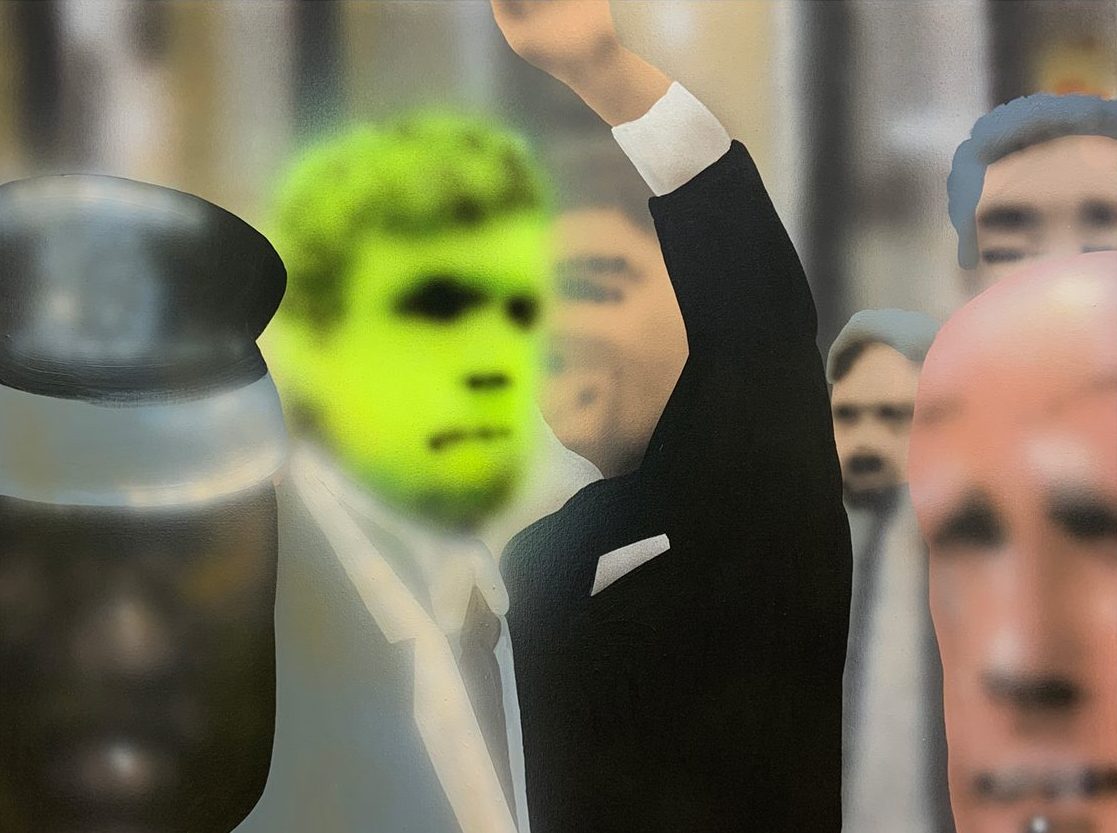

Memes are another ripe source of inspiration for him. Gao admires their irreverence and honesty, but also the fact that they proliferate easily. “Let’s be honest: the idea of copyright is gone. It doesn’t matter anymore—just like the people who made these images don’t matter,” he jokes. But there’s a grain of truth in his saying. Online content is easy to download and reproduce, rendering its creators irrelevant. Memes are, perhaps, the best example of this phenomenon: what matters is that they propagate through the internet, from one user to another, in endless derivatives of the original.
“互联网段子”和“迷因”则是他的另一个重要灵感来源。高航认为各种网络热梗很有意思,它们大胆而直接,往往传播效率很高。他开玩笑地说:“老实讲,网络时代的版权概念已经不复存在,甚至已经不再重要了。同样,甚至根本没人在乎这些段子的原创作者是谁。”虽然是玩笑话,但也绝非毫无道理。网络内容的下载和复制总在一键之间,其背后的创作者被高速流量迅速遗忘。互联网段子或表情包则是铁打的映证,它们无穷无尽地传递至每一个人的手机里,甚至被无数次改编,而论其出处却往往无人问津。
Gao grew up in Baoding, a relatively small Chinese city, in an open-minded household compared to most of his peers. As a child, his parents took him on trips to nearby historical villages so that they could all draw and paint the idyllic scenery. Since then, he hasn’t stopped making art. Gao received his bachelor’s in oil painting from the Capital Normal University in Beijing and his master’s in painting and drawing from the University of Houston. In Beijing, his earlier works were “absolutely dark,” he says, “a dark fairytale ruled by academic realism. Ridiculous. But very honest for a twenty-year-old.”
高航从小生活在中国保定,与大多数同龄人相比,他的父母还算相对开明。小时候,父母带他到附近的农村旅行,陪他一起画画,写生当地的田园风景。从那时起,他就没有停止过艺术创作的步伐。从首都师范大学油画系毕业之后,他来到休斯敦大学修读绘画硕士学位。他称自己早期在北京的作品非常暗黑:“就像是被学术现实主义统治的黑暗童话,荒唐可笑,但对于一个 20 来岁的年轻人来说,却很好地反映了那时候的状态。”
When he moved to the United States, his subject interests and style changed. Suddenly overwhelmed by an endless array of information about art that he could find in the school library he studied the lives of the great artists he admires, such as Andy Warhol, Benjamin Butler, and David Hockney. A more colorful style emerged, together with the appearance of elements from contemporary American pop culture, such as images of celebrities, basketball culture, and Nike sneakers. “Some of these are very American things, but they’re popular in the entire world,” he says. “I am overwhelmed by how crazy people everywhere react to these symbols.”
移居美国后,他的专业兴趣和艺术风格都发生了变化。他沉浸在学校图书馆无穷无尽的知识海洋里,研读那些伟大的艺术家生平 —— 安迪·沃霍尔、本杰明·巴特勒和大卫·霍克尼。他的作品风格变得更加丰富多彩,尝试与当代美国流行文化连结,如名人肖像、篮球文化和耐克运动鞋。他说:“这些元素在全世界都很受欢迎,人们对于这些元素的疯狂程度常常令我大开眼界。”
Rather than discussing differences between his motherland and his newfound home in the United States, Gao prefers focusing on their similarities. “If there is a culture that represents my generation, it is social media culture,” he says. “And it doesn’t matter where you come from or where you live—we are all in the digital world.”
比起讨论中国和美国之间的差异,高航更喜欢着眼于现在。他说:“如果说有一种文化代表了我这一代人,那应该是社交媒体文化。不管你来自哪里,住在哪里,我们都生活在同一个数字世界里。”
Like our stories? Follow us on Facebook and Instagram.
Website: www.gao-hang.com
Contributors: Tomas Pinheiro, Lucas Tinoco
Chinese Translation: Olivia Li

